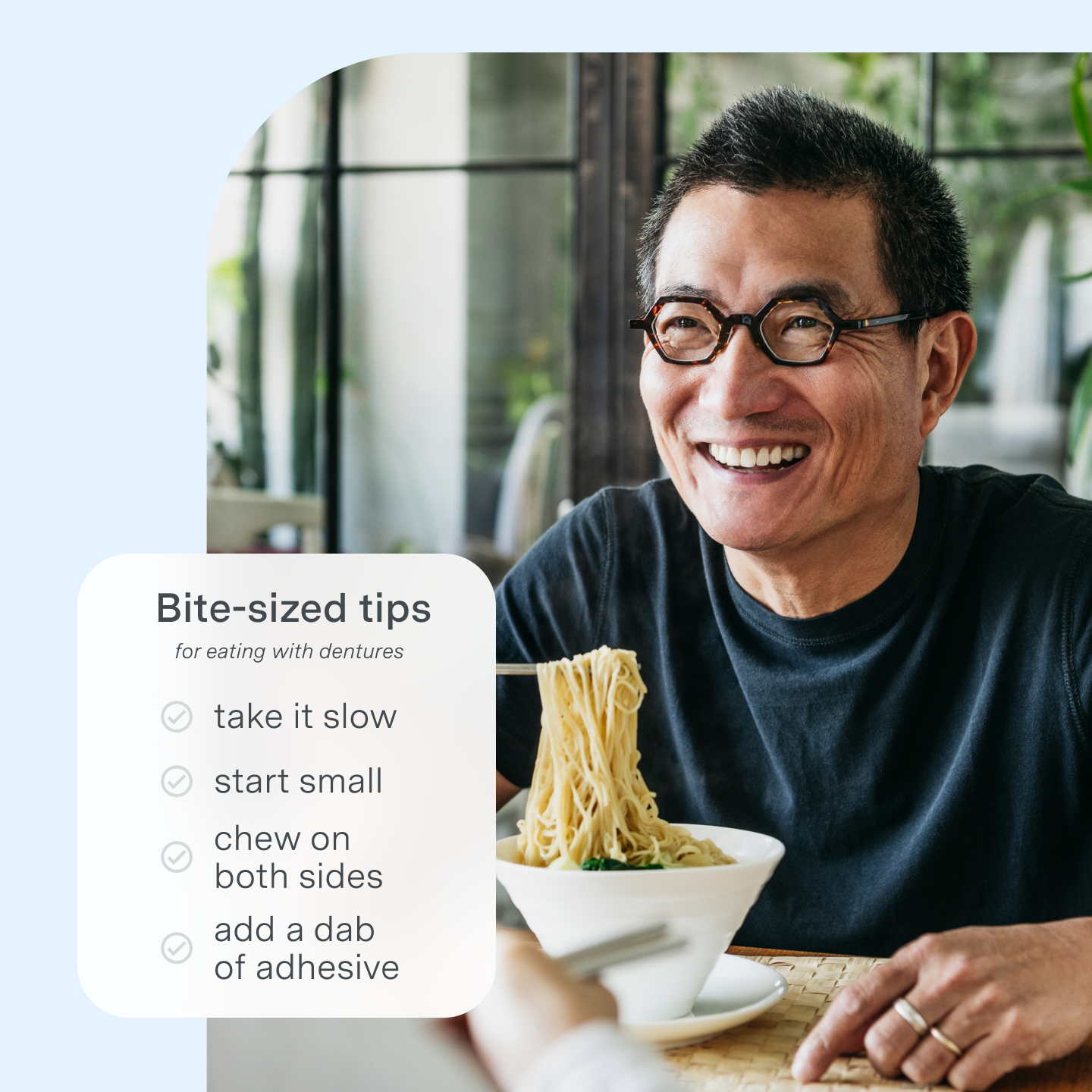
How to eat with dentures
Eating with dentures can feel unfamiliar at first. Until you get comfortable, enjoy food in no time by:
Chewing slowly
Taking small bites at the beginning
Chewing food on both sides of your mouth to prevent your denture from rocking or loosening
Applying a small amount of denture adhesive for extra stability
Hungry for more?
Check out our food recommendations and adhesive application tips.
Things you can eat with dentures
Choosing dentures doesn’t mean giving up your favorite foods. Learn what’s on the menu and when as you get used to dentures.

Soft foods only
When you’re starting your healing journey, you and your gums will need R&R time. Treat your gums with care by preparing soft, nutritional foods that are easy to eat without causing irritation. Enjoy foods like:
Protein shakes & smoothies
Lukewarm soup
Soft breads & pasta
Mashed potatoes
Applesauce & hummus
Skip: hot foods, chewing gum, nuts and foods that may cause gum pain.

Expand your options
As you get the hang of eating with dentures, reward yourself with new meals on the menu. The better your mouth feels, the more you can add firm foods back into your diet, such as:
Stewed or slow-cooked meats
Cooked veggies & rice
Eggs
Expert insight: if you wear an upper denture, food may taste a bit different. While this is normal due to the roof of your mouth being covered, you can explore upgrading to an implant denture so food tastes like new.

Enjoy what you want
Delicious news! After your new denture is a comfortable part of your daily life, you can get back to most of the tasty treats you enjoy, such as:
Ground meats
Most ripe fruits
Desserts & chocolate
Chips (occasionally)
Remember: chew thoroughly and add proper cleaning and care to make your denture(s) last.
Things you can’t eat with dentures
Foods off the menu
To make sure your denture fits long-term, take a pass on:
Tough or hard foods
Creamy foods (nut butters)
Dense foods (dense bread)
Chewy or sticky foods (gum, taffy, etc.)
Extremely hot/cold foods (while healing)
For more tips to get the most out your denture, explore our denture care resource.
Adhesives for dentures
Learn how to apply denture adhesive like a pro to skip slippage and discomfort while eating. For recommendations on which adhesives to use, talk to your local care team.

Upper arch
Get your denture clean and dry
Hold the arch, teeth facing the floor
Apply 1 dime-sized dollop to the top of your denture at the center
Insert and bite down for 1 minute
Pro tip: Skip smoothing the adhesive with your finger; when you bite down, the adhesive will naturally spread out.

Lower arch
Get your denture clean and dry
Hold the arch, teeth facing the floor
Apply 4 small drops in a U-shape, following the denture gum line
Insert and bite down for 1 minute
Reapply check!
If you choose to use adhesives, reapply after drinking liquids or eating. For a fresh fit, make sure to:
Rinse your denture of debris & residue
Dry your denture
Reapply adhesive
Reinsert and bite down
Don’t love adhesives?
Explore implant dentures.
